Murder in the brothel – Raya, Sakina and the 17 female corpses
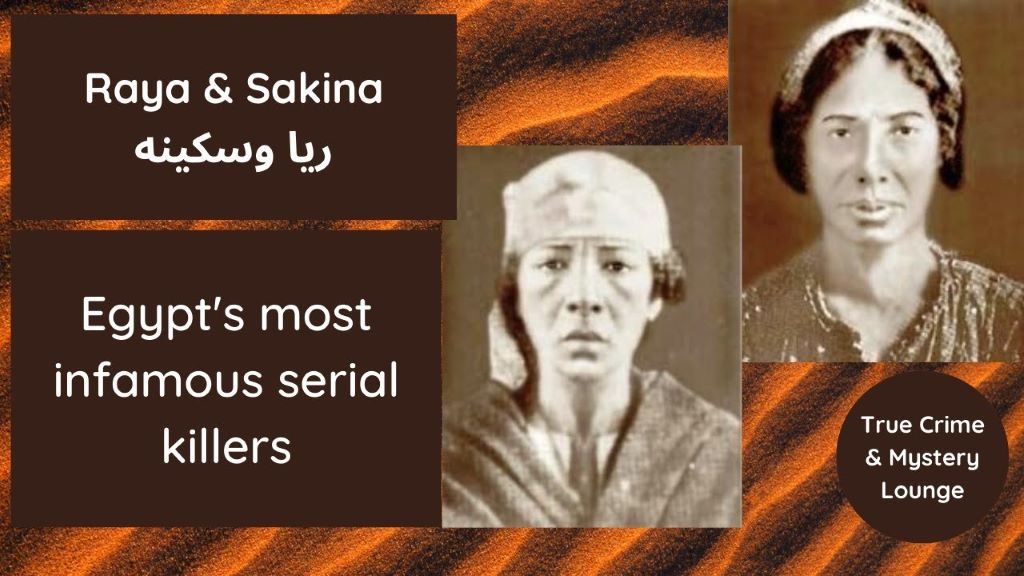
The "khawaga", or "foreigner", had special requests. Had he not expressed them, the bodies might have remained buried for a long time. In November 1920, the Italian gentleman wanted to move his family into the house in Alexandria, Egypt's Mediterranean port city. The previous inhabitants had been kicked out by the landlords, after having "gathered thieves, pimps and prostitutes [there] … turning the house into a brothel", according to the book "The Men of Raya and Sakina", by Salah Eissa. Now, the landlords wanted a respectable tenant for the three-story building in Makoris Alley No. 5. And if the khawaga needed running water in the kitchen and bathroom, he should have it.
On Sunday, 14 November 1920, the landlord sent his nephew Ahmed Mursi – known as "the disabled" for his bad eyesight – to search for the water pipes beneath the building. Mursi began by knocking out some of the floor slabs and digging through the chalk and gravel below, surprised that the ground wasn't rock solid.
Suddenly, his hatchet hit something. Was it a water pipe? If so, it must have been filled with something putrid, for a terrible smell filled the air. Mursi reached in with his hands to investigate what could possibly be the culprit. Feeling his way in the dark rubble, he grabbed onto something loose. He lifted it up close to his eyes so he could make out what he was holding. It was a human arm.
The arm belonged to a woman named Nabawiya bint Ali. She had been missing for three months. Two more bodies were found underneath the room that had been inhabited by Sakina Ali Hammam. Fourteen more turned up nearby. Most of them were buried under the apartment of Sakina's sister, Raya.
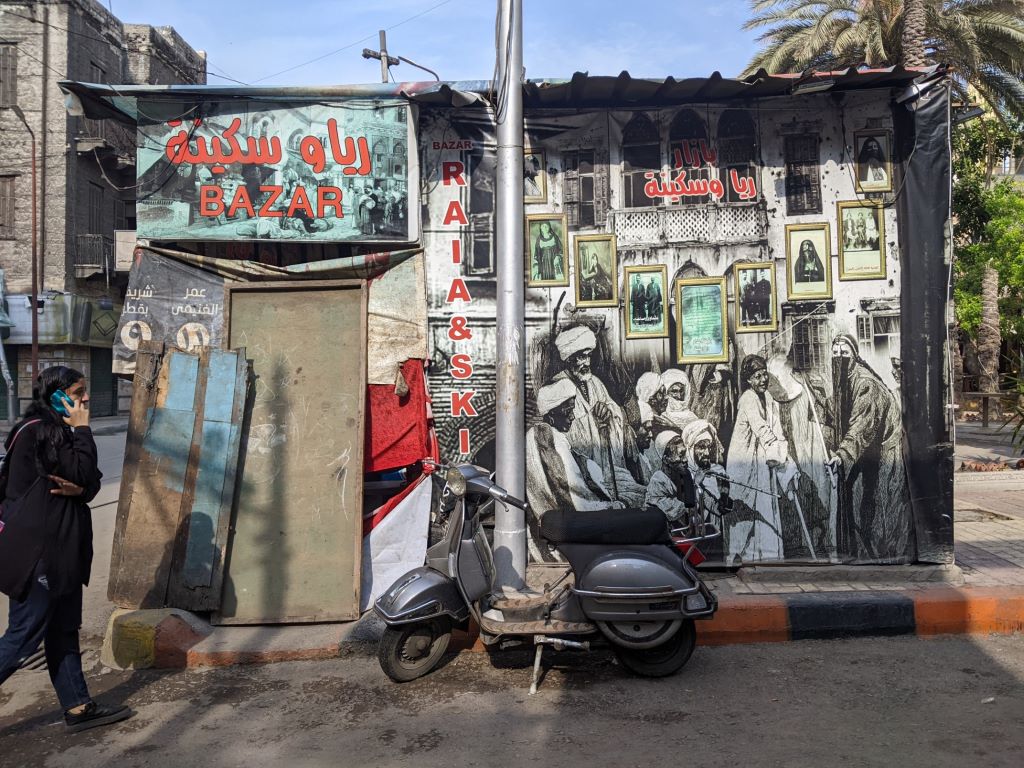
Were the women really the main perpetrators?
Seventeen women, most of them sex workers, had previously disappeared in Alexandria's Labban district. Several had last been seen in the company of one of the two brothel owners, Raya and Sakina. A friend of Nabawiya had even noticed Sakina wearing the disappeared woman's clothes, according to one account in Eissa's book. The police had summoned the sisters several times, but it was the search for water pipes that triggered the investigation into one of the most spectacular serial killings in the history of Egypt.
Most people know this potted version of events: the sisters Raya and Sakina Ali Hammam ran several brothels in Alexandria during and after World War I. In 1919 and 1920, they allegedly killed 17 women, stole their gold jewellery and buried them in their own homes. In 1921, they were the first women to receive the death penalty in Egypt.
Just like Jack the Ripper in Europe, the two sisters are known in the Arab world as icons of horror. Parents use their story to warn their children not to go out alone after dark. But Raya and Sakina have also made their way into popular culture. Everyone in Egypt knows the comedy play that tells their story, which has also been adapted into countless TV shows, books and films – one written for the screen by Egypt's most famous novelist and Nobel Prize winner, Naguib Mahfouz.
Yet, according to new research, the story of Raya and Sakina does not add up. Did the two brothel operators really kill their employees, some of them close friends, for a few gold bracelets? What role was played by the four men who were sentenced to death alongside them? According to the new findings, the facts about these killings were mixed up in the political transformations undergone by then-colonised Egypt, the sensationalism of certain newspapers at the time and the sheer number of different stories created for the entertainment industry ever since. A century later, the search for the truth continues.
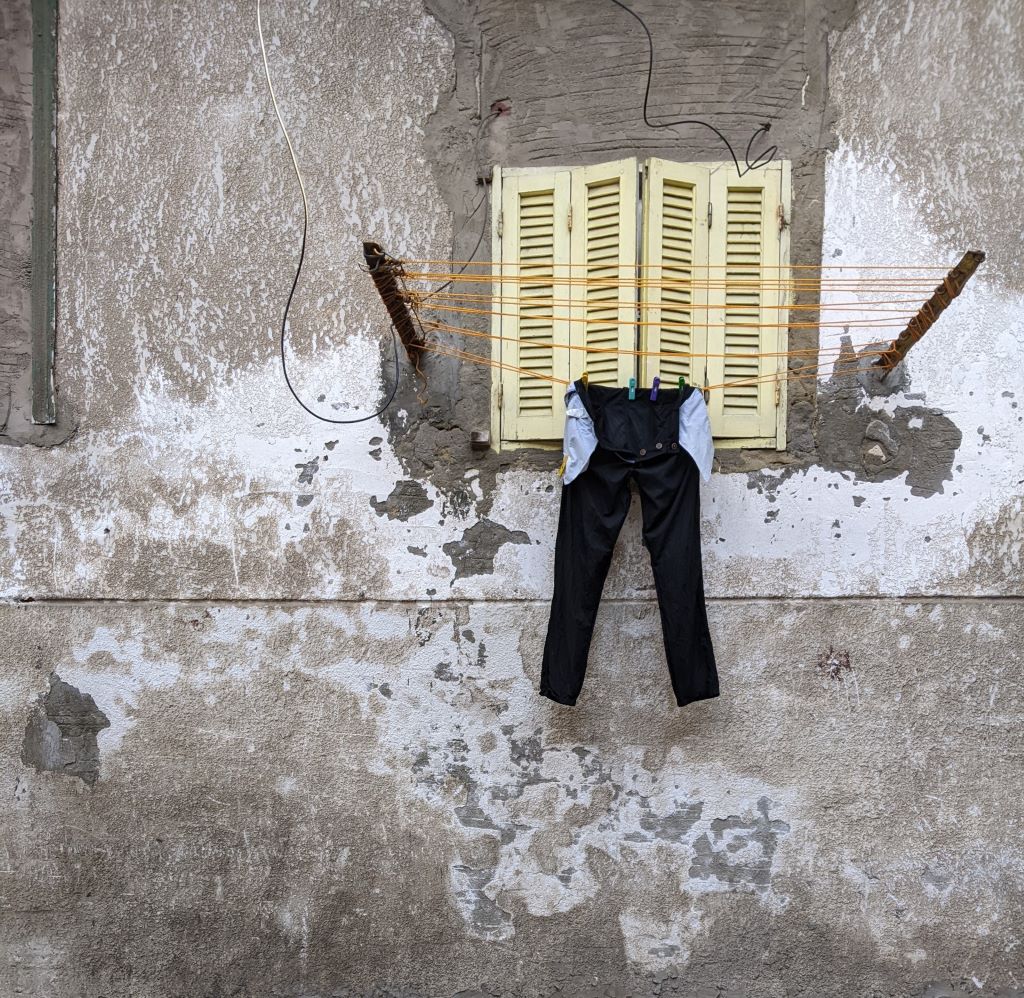
One hundred years later
As a German Egyptian who has spent most of my life outside of Egypt, I was not indoctrinated to fear Raya and Sakina, but I did hear about them at an early age. The phrase "Raya and Sakina", as they are always referred to in folk culture, is a cornerstone of my cultural memory, despite having grown up elsewhere; something like the American duo Thelma and Louise, if you overlook the murder part. The pair have become more of an institution or brand than two real individuals who lived full lives.
It was much later, in my early adulthood, when I was working as a journalist on sociopolitical topics in Egypt and the region that I realised how interesting their story was and how skewed the facts have become. Serial killer stories have a strange allure, and true crime is a popular genre these days. But to Raya and Sakina, there is more: that they were running a business and supposedly killing people at a time and place where most women were still restricted to the household – and the fact that they were women – captivated people's imagination. What most fascinated me was the world they inhabited; that vibrant, messy underground world of sex, drugs and crime, maybe overly romanticised in my mind, but remarkable because it eluded the authority of a state controlled by British colonisers.
Alexandria's Labban district is just a 20-minute walk from the main train station and equally close to the port. The area along its central Sabaa Banat (Seven Girls) Street was densely populated around 1900 and was the go-to place for anyone in search of a lover, quick cash or a numbing bottle of liquor. The marketplaces bustled with street vendors and sex workers; the bars with workers from Egypt, Malta or Greece. Refugees from Eastern Europe and Syria crowded into cheap apartments that were rented out by the room.
Alexandria was renowned as a hotspot for prostitution at the time. The red-light districts were not isolated areas of town but could be found near police stations, hospitals, marketplaces – they were part of the cityscape.
Prostitution was not illegal, but the British colonial regime tried to subject the industry to stricter rules to protect their soldiers from venereal diseases and keep up the troops' morale. For example, sex workers had to be tested weekly for sexually transmitted diseases and were forced to stay in hospital if they were not healthy. But that just pushed more sex workers into unlicensed work – including Raya and Sakina, who opened several clandestine brothels and rented out their own rooms to sex workers.
I arrived in Alexandria's main station one Sunday last November. I was excited that it was the same day that the first body had been discovered 102 years earlier. I had come to Egypt on one of my regular visits and taken the train from Cairo to explore the places where Raya and Sakina had lived, worked and buried the bodies. Fittingly, on my first day there, grey clouds darkened over the city and the streets were riddled with big brown puddles. The air smelled of dust and the sea.
Outside a fish restaurant, I stumbled upon a scene: a young woman with a defiant glare in her eyes was being arrested. Her left hand was shackled to the right hand of a plainclothes police officer who was escorting her away. It was not clear what she had done, but I thought about Raya and Sakina and how they were arrested here about a century earlier. After a short walk, I arrived at Labban's busy streets, where vendors offer knockoff handbags, cheap jewellery and piles of eggplants. A dented tram squeezed through the main street, passing by horse carriages and delivery vans. Tuk-tuks blared tinny music.
At an intersection leading westward to the port, the tight street suddenly opens onto a quiet, spacious square with tall palm trees. Along the wall of a large building, portraits of Raya and Sakina hung between old wooden windows, accompanied by photos of their husbands and the officer who investigated their case. The customers of a nearby coffee shop smoked shisha and drank tea as they played dominos. A girl with a pink schoolbag sat with her father, seemingly oblivious to the images of brothel owners that dangled above her head.
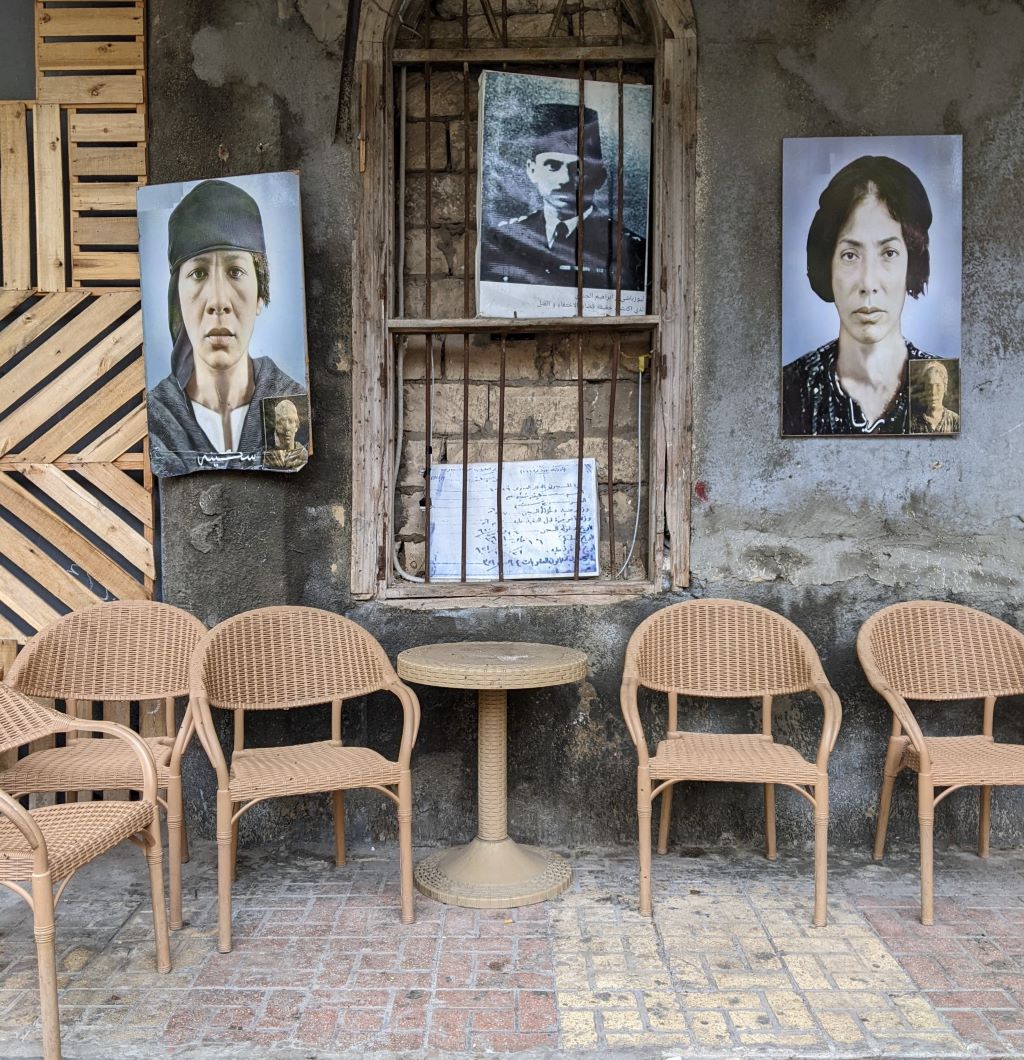
"The men were merely the women's dupes"
The open-air exhibition was put up by Saeed Mohammed, a native of Labban who wears pointy leather shoes and a mischievous smile. I found him drinking tea and smoking in front of a small kiosk on the edge of the square. Nine years earlier, he and his brother opened their shop and called it "Bazaar Raya and Sakina". It is in the same location where the police station of Labban used to be, across the square from Sakina's living quarters and a few blocks down the road from Raya's home. Locals sometimes get annoyed when asked about the dark history of their district, the 32-year-old Mohammed told me, but that hasn't deterred him. He wants to make the story accessible for tourists.
"What's crazy is that they buried the victims under their houses," Mohammed said. "How could they sleep on top of dead bodies?" The smell alone must have been unbearable, he suggested, adding that "they used incense to cover it up". For him, Raya and Sakina were the main perpetrators. And the men? They were the women's dupes. "They merely buried the bodies," he said.
When the first victim was discovered, news spread rapidly throughout Alexandria. Research shows there were around 20 suspects, yet the local newspapers seem to have come to a verdict too quickly, immediately focusing their suspicions on Raya and Sakina. Their portraits were circulated in the square and sold like wildfire around town.
"Their names were carved into people's memories with bloody letters, that the tongues circulate and the lips cannot stop repeating," wrote Eissa in his book. The illustrated 500-page tome is prominently displayed at the entrance of a bookshop in downtown Cairo, even though it has been out for more than 20 years.
Nonetheless, Eissa, who died in 2017, was the first to research the sisters' biographies thoroughly, using police and court files. He argues in the book that the two women were depicted as "icons of evil", robbed of their personality and history.
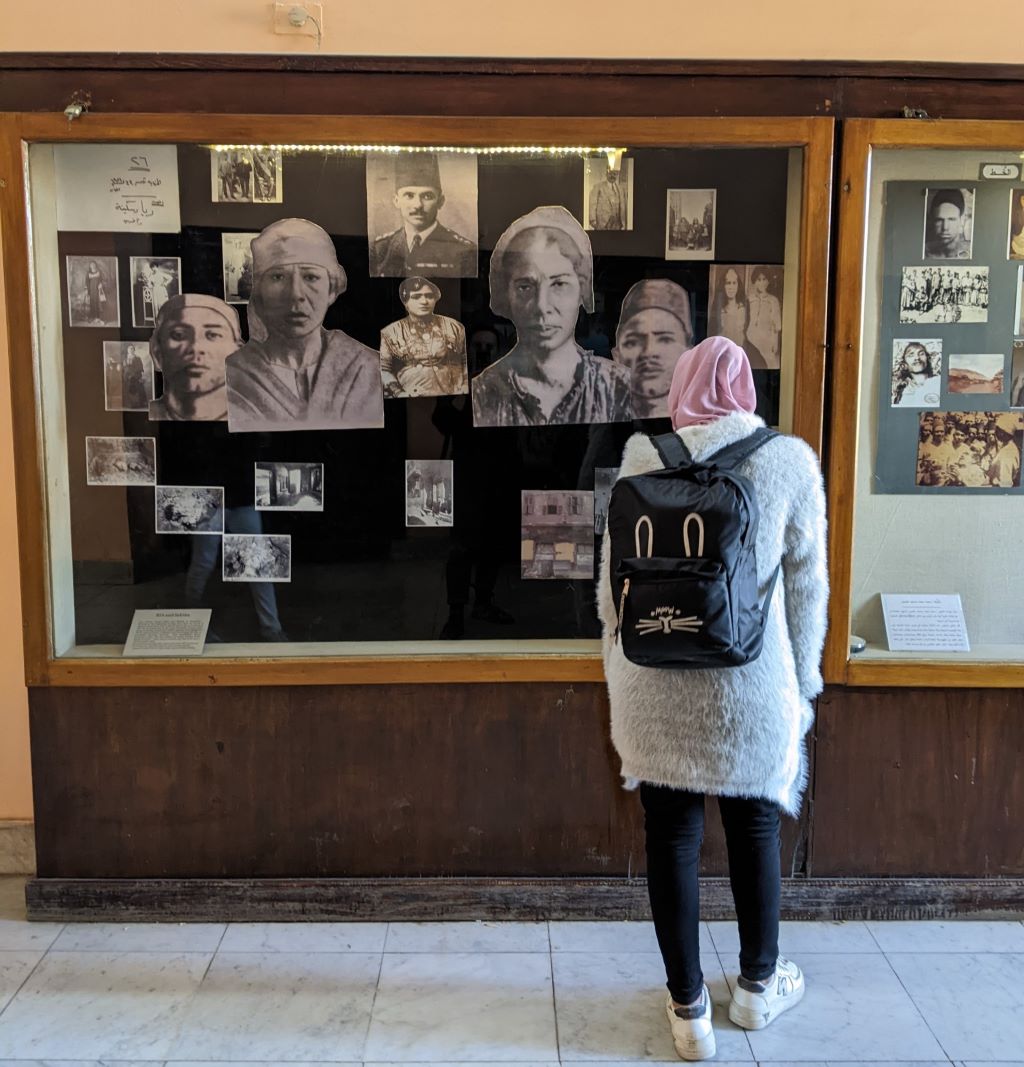
The hardships of economic crisis – then as now
"The sisters originally came from Upper Egypt and, running from poverty, travelled North along the Nile in search of a bite that could defeat the devastation of hunger", until they arrived in Alexandria, where "tight, dark rooms lay in even tighter alleys, that wrapped around each other and from which blew the winds of misery and the smell of decay," writes Eissa.
A well-known TV series from 2005 is based on Eissa's book and is available on YouTube. I binge-watched the 35 episodes of soapy but informative Egyptian drama while lounging on the sofa at my grandmother's apartment in Cairo. The show follows Raya and Sakina from their life of extreme poverty in the countryside to Alexandria, where they eventually end up in the unlicensed sex work industry.
It presents Raya as a simple but conniving, constantly pregnant woman with pieces of string in her earlobes instead of rings. She is devoted to her lazy, criminal husband Hasaballah and, because of him, becomes a burden on her younger sister Sakina, an alcoholic with seductive, black-framed eyes who is trying to stay on the straight and narrow with her husband Abdul Aal.
He keeps pleading with her to get out of the illegal business of hash dens and brothels. Both of them try to find work that is "halal" – but every time they succeed in making a modest living, Sakina's family barges into their lives, broke and unemployed, needing to mooch off of them to survive.
Egypt was going through difficult times. During World War I, the British occupation monopolised the sea routes, blocking the trade that had provided jobs to the country. The situation only grew worse after the war. Egyptian men who had been recruited for the war industry came back unemployed. At the same time, the price of basic foods like beans and lentils doubled between 1919 and 1920.
Today's Egyptians, too, are struggling with rising food costs and a seemingly endless economic crisis. In this environment, and after Eissa's book and the TV series revealed the hardship that had pushed the Ali Hammam family into crime, sympathy for the two sisters grew.
The author discovered another surprising fact in the 2,220 pages of investigation files he went through: Raya and Sakina were convicted as accomplices, while their husbands as well as two brothel guards were found guilty as the main perpetrators of the murders. Moreover, both sisters testified that the men had forced them to cooperate.
Sakina told the state prosecutor that the men had killed the women and threatened to kill her as well if she spoke about the killings. Raya testified that the men beat her whenever she tried to protest what they were doing.

Eissa describes one of the murders in detail. Nasla Abulleil, the second of the 17 victims, worked as a tailor and regular sex worker in Raya and Sakina's brothel. As many men were gone during the war, it was not unusual for even married and middle-class women to make some extra money through sex work. Many worked the streets, turning tricks by flashing their gold and fancy clothes to attract clients. Nasla, 24, was a close friend of the sisters and a lover of one of the security guards.
According to the court files, she was lured into Raya's apartment on 4 January 1920, where the men were already waiting. They offered her a strong mixture of whisky, cognac, wine and arak. When she wanted to leave, the men grabbed her and put a wet cloth over her mouth and nose. Raya, who could not bear the sight, left the room. Sakina was too shocked to move and wet herself.
"The girl gargled, as if her mouth were full of water or as if she were drowning," Sakina later told the investigator. "They held her down, until she stopped breathing." Nasla died of suffocation, like all the other victims. The gang took her gold jewellery and buried her under the floor of the room. The official motive given for the crimes was the theft of the victims' jewellery, which the gang later sold.
Yet Nefertiti Takla, an associate professor of modern Middle Eastern history at Manhattan College, does not believe that necklaces and bracelets were the reason these women were killed. After all, how difficult would it have been to demand that the women turn over any treasure they possessed? Why kill them when they could have easily robbed them? Besides, several of the victims were hardly wearing any jewellery when they were killed, wrote the historian in her 2016 dissertation.
Instead, Takla sees a number of alternative motives. Almost all the women had regularly worked in Raya and Sakina's brothel in the past. Some allegedly cheated them out of money or became competitors. One woman was recruiting girls as domestic workers – a profession that also doubled as sex work at the time – thereby taking them off the job market, where Raya and Sakina were always looking for new people. Some victims had relationships and conflicts with the gang's men. Most likely, several of them were raped before their death, a possibility that was not investigated or raised during the trial.
One argument in Takla's dissertation particularly blew my mind: that maybe the murders were not committed by the gang of Raya, Sakina and their men, but were instead the work of a serial rapist, namely Raya's husband Hasaballah. "Yet the state prosecutor was so convinced that the murders were perpetrated by a gang of robbers," Takla writes, "that he prevented Ḥasaballah's attorney from obtaining a psychiatric evaluation to determine whether his client was clinically insane."
Demonised by the press
On 21 December 1921, Raya and Sakina were the first women in Egypt to be hanged on the basis of a death sentence – even though they had not been convicted as the main perpetrators. "Before the trial even started, the press had already spent months demonising them," says the historian Elena Chiti, who is researching their case at Stockholm University.
She analysed the news coverage of the case by one of Egypt's biggest newspapers, Al-Ahram, and described how their correspondent spoke only of Raya and Sakina, omitting their last names or the names of the other suspects, even going so far as to mention their husbands, the main perpetrators, merely as "Raya's husband" and "Sakina's husband".
"Raya and Sakina become central in every account," writes Chiti, "not only linked to prostitution and murder in an impersonal way, but to the scary 'dark' rooms, similar to 'graves' or 'caverns', where they accomplished their 'satanic acts'."
Other newspapers, too, published only the sisters' photos, ignoring those of the other suspects. The daily news coverage dramatized the sisters' role, even if this meant misreporting the facts. Several journalists argued they should be executed, even though no woman had ever been sentenced to death in Egypt. With their vulgar language, their fondness for alcohol and their sexual promiscuity, Raya and Sakina had become "symbols of moral decline under the British colonial rule", Chiti says.
At the time, an anti-colonial, nationalist movement culminated in revolution in 1919, and was accompanied by notions of the ideal citizen, Chiti relates: "Female criminals did not fit into the image of the new Egyptian woman that was necessary to build a new Egypt." Chiti believes the women were unjustly sentenced to death, "not because they were innocent, but because they were not the main perpetrators".
What continues to puzzle me, though, are Sakina's last words, according to the prison's medical report: "I'm a strong woman and I'm going to be hanged at the place where strong people stand. I killed seventeen women and I fooled the government." These words contradict her earlier claims that the men forced her to participate and keep quiet. Perhaps this was just the last defiant statement of someone who had never stood a chance to prove their innocence, someone about to be hanged. After all, there is no evidence or testimony stating that she personally killed anyone, let alone 17 women. In any case, her last words suggest that Sakina saw herself acting in resistance to state power.
When Chiti visited Alexandria a few years ago, she was surprised to find that some people took offence at her calling Raya and Sakina criminals. They claimed the sisters were anti-colonial fighters who had fallen victim to a British conspiracy. This theory has recently become popular in Egypt. It was started by the filmmaker Ahmed Ashour, who announced he was working on a film called "Raya and Sakina's innocence". He argues the pair were working as agents for a revolutionary cell, collecting information on the British soldiers frequenting their brothels. Moreover, he claims the sisters were convicted under pressure from the British colonial administration, to distract the population from the anti-colonial uprisings of 1919, and to scare women away from the public space, where many were participating in demonstrations.
There was indeed an unprecedented turnout by women in the protests of that time, says Chiti. However, "there are no historical sources indicating that Raya and Sakina were anti-colonial fighters". The reason this theory is so popular today, Chiti believes, lies in the 2011 revolution that ended in a military dictatorship two years later. "The myth of the bandit hero emerges when people feel oppressed with no hope of fighting back." Since 2011, Chiti has observed a general trend of reappropriating and, sometimes, rewriting history. She is still exploring how this could be related to a need for nationalist glorification and the rejection of foreign intervention.
There is logic to this line of interpretation: that the struggle for national identity and pride after a failed revolution should lead to nostalgia for past revolutions and a feeling of solidarity with anyone opposing the unjust and oppressive regimes of those times. Raya and Sakina were already rebels by working in an underground business and defying the British authorities. The fact they were also poor, because an exploitative state failed to provide the population with jobs and affordable food, must make it all the easier for modern-day Egyptians to sympathize with them and even paint a picture of them as full-on fighters against colonialism.
In the course of a century, the image of Raya and Sakina has been transformed. First, they were symbols of evil; now, many Egyptians see them as victims of poverty and injustice, or even anti-colonial resistance fighters. When I asked Egyptian friends and family about the sisters, many raved about how funny they were: They mainly associated them with the early 1980s comedy play. Another friend told me she used to visit their houses in Alexandria, where she felt a spiritual connection to them. She even claimed the windows of the houses were in different spots each time.
"Every epoch, maybe even every person, has their own version of Raya and Sakina," Chiti tells me, laughing. It is hard to determine today what the sisters' roles in the murders really were. But their story explains a lot about all those who have recounted it in so many different ways.
© Qantara.de 2024